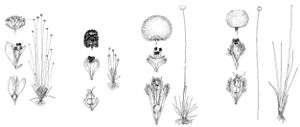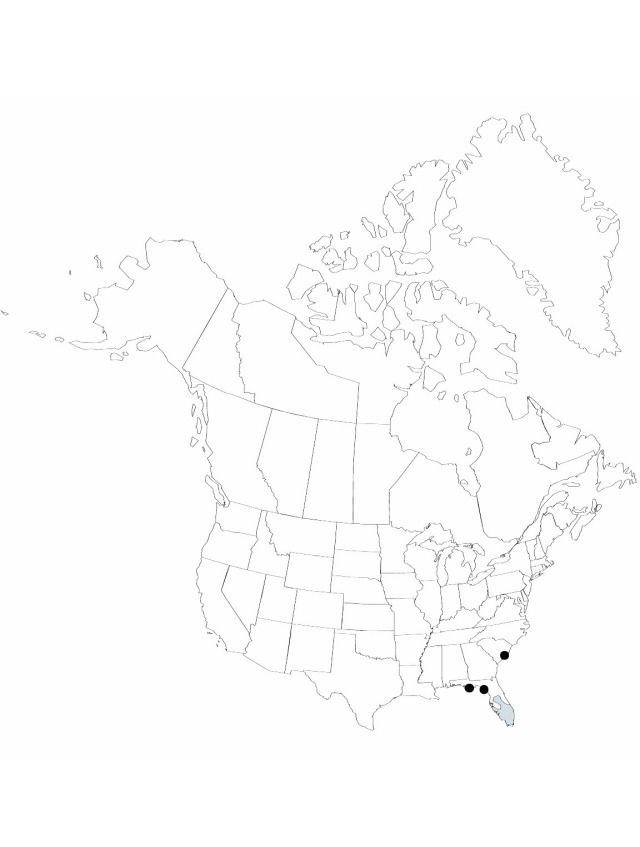Difference between revisions of "Eriocaulon ravenelii"
Fl. South. U.S. 503. 1860.
FNA>Volume Importer |
imported>Volume Importer |
||
| (6 intermediate revisions by 2 users not shown) | |||
| Line 6: | Line 6: | ||
|place=503. 1860 | |place=503. 1860 | ||
|year=1860 | |year=1860 | ||
| + | }} | ||
| + | |special_status={{Treatment/ID/Special_status | ||
| + | |code=F | ||
| + | |label=Illustrated | ||
| + | }}{{Treatment/ID/Special_status | ||
| + | |code=E | ||
| + | |label=Endemic | ||
| + | }}{{Treatment/ID/Special_status | ||
| + | |code=C | ||
| + | |label=Conservation concern | ||
}} | }} | ||
|basionyms= | |basionyms= | ||
| Line 32: | Line 42: | ||
-->{{#Taxon: | -->{{#Taxon: | ||
name=Eriocaulon ravenelii | name=Eriocaulon ravenelii | ||
| − | |||
|authority=Chapman | |authority=Chapman | ||
|rank=species | |rank=species | ||
| Line 46: | Line 55: | ||
|publication title=Fl. South. U.S. | |publication title=Fl. South. U.S. | ||
|publication year=1860 | |publication year=1860 | ||
| − | |special status= | + | |special status=Illustrated;Endemic;Conservation concern |
| − | |source xml=https:// | + | |source xml=https://bitbucket.org/aafc-mbb/fna-data-curation/src/2e0870ddd59836b60bcf96646a41e87ea5a5943a/coarse_grained_fna_xml/V22/V22_171.xml |
|genus=Eriocaulon | |genus=Eriocaulon | ||
|species=Eriocaulon ravenelii | |species=Eriocaulon ravenelii | ||
Latest revision as of 20:29, 5 November 2020
Herbs, biennial or perennial, 4–20 cm. Leaves linear-attenuate, 3–7(–15) cm, apex subulate, flat. Inflorescences: scape sheaths shorter than leaves, loose; scapes filiform, 0.5 mm wide, 4–5(–6)-ribbed; heads gray-brown to dark gray, nearly globose or ovoid, 3–4 mm wide, relatively soft; receptacle glabrous or with sparse, clear hairs; outer involucral bracts usually not reflexed, not obscured by bracteoles and perianth, gray, ovate-oblong or broadly spatulate, 2 mm, margins nearly entire, apex narrowly rounded to acute, surfaces glabrous; inner bracts, receptacular bracts gray, very lustrous, narrowly ovate to oblong or spatulate, 2 mm, margins nearly entire, apex acute to acuminate or lacerate, glabrous. Staminate flowers: sepals 2, gray, oblong to oblanceolate, 1.5–2 mm, apex usually acute, glabrous; androphore narrowly club-shaped; petals 2, pale, scalelike, minute, glabrous, with inconspicuous glands; stamens 4; anthers black. Pistillate flowers: sepals 2, gray, narrowly oblong to lance-linear, 1.5–2 mm, apex acute, glabrous; petals 2, yellow-white, narrowly oblanceolate or oblong, 1.5–2 mm, apex acute, glabrous or with a few hairs at apex or adaxially, with inconspicuous glands; pistil 2-carpellate. Seeds dark brown, somewhat lustrous, broadly ellipsoid, 0.5 mm, conspicuously irregularly pale-reticulate, alveolae mainly rectangular.
Phenology: Flowering late summer–winter.
Habitat: Mildly acid sandy pineland swamps, particularly on wet fluctuating shores of shallow ponds toward coasts
Elevation: 0–100 m
Discussion
Of conservation concern.
Selected References
None.

